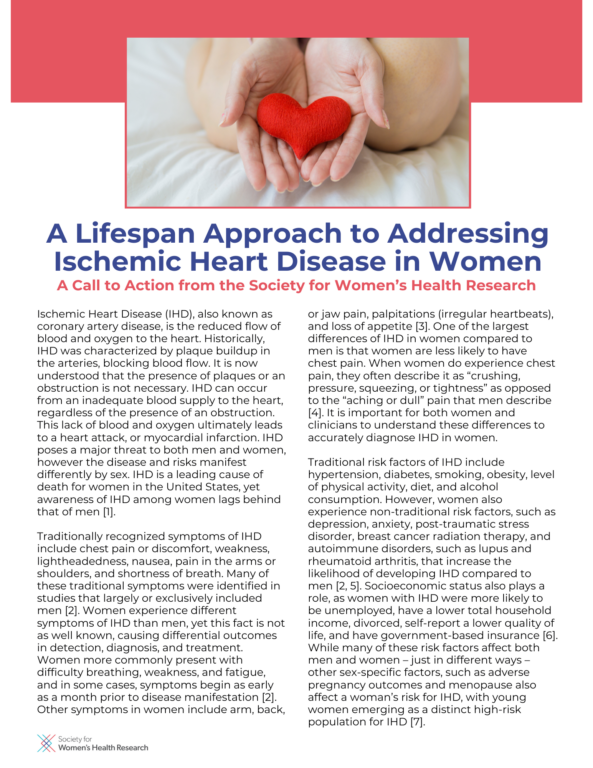Additional Resources
References
1McSweeney JC, Rosenfeld AG, Abel WM, et al. Preventing and Experiencing Ischemic Heart Disease as a Woman: State of the Science. Circulation, 2016 Mar 29;133(13):1302-1331.
2Garcia M, Mulvagh SL, Bairey Merz CN, et al. Cardiovascular Disease in Women. Circ Res, 2016 Apr 15;118(8):1273-1293.
3Lee Y-TH, Fang J, Schieb L, et al. Prevalence and Trends of Coronary Heart Disease in the United States, 2011 to 2018. JAMA Cardiol, 2022 Apr 1;7(4):459-462.
4Virani SS, Alonso A, Aparicio HJ, et al. Heart Disease and Stroke Statistics—2021 Update. Circulation, 2021 Feb 23;143(8):e254-e743.
5Breathett K, Sims M, Gross M, et al. Cardiovascular Health in American Indians and Alaska Natives: A Scientific Statement from the American Heart Association. Circulation, 2020 Jun 23;141(25):e948-e959.
6United States Department of Health and Human Services (US DHHS), Centers for Disease Control and Prevention (CDC), National Center for Health Statistics (NCHS), Underlying Cause of Death by Single Race 2018-2020 on CDC WONDER Online Database, released 2021. Data are compiled from data provided by the 57 vital statistics jurisdictions through the Vital Statistics Cooperative Program. Data for year 2018 are compiled from the Multiple Cause of Death File 2018, Series 20, No. 2X, 2020. Accessed at https://wonder.cdc.gov/controller/saved/D76/D282F136 Accessed 5 April 2022.
7Khandelwal A, Bakir M, Bezaire M, et al. Managing Ischemic Heart Disease in Women: Role of a Women’s Heart Center. Curr Atheroscler Rep, 2021 Aug 4;23(10):56.
8Global Health Estimates 2020: Disease burden by Cause, Age, Sex, by Country and by Region, 2000-2019. Geneva, World Health Organization; 2020.
9Kaiser Family Foundation State Health Facts. Health Insurance Coverage of the Total Population (CPS). Data Source: Census Bureau’s March Current Population Survey (CPS: Annual Social and Economic Supplements), 2017-2022. https://www.kff.org/other/state-indicator/health-insurance-coverage-of-the-total-population-cps/?currentTimeframe=0&sortModel=%7B%22colId%22:%22Location%22,%22sort%22:%22asc%22%7D. Accessed 14 June 2022.






